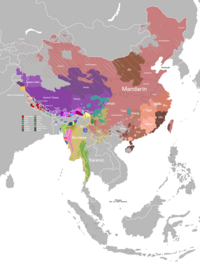Takpa language
You can help expand this article with text translated from the corresponding article in French. (February 2016) Click [show] for important translation instructions.
|
| Takpa | |
|---|---|
| Tawang Monpa | |
| དག་པ་ཁ་, dakpakha | |
 | |
| Region | India; Bhutan; Lhoka, Tibet |
| Ethnicity | Takpa |
Native speakers | 9,100 in India (2006)[1] 2,000 in Bhutan (2011);[2] 1,300 in China (2000 census)[3] |
| Tibetan script | |
| Language codes | |
| ISO 639-3 | Variously:dka – Dakpatwm – Tawang Monpatkk – Takpa |
| Glottolog | dakp1242 |
| ELP | |
 Takpa is classified as Vulnerable by the UNESCO Atlas of the World's Languages in Danger | |
The Takpa or Dakpa language (Tibetan: དག་པ་ཁ་, Wylie: dak pa kha), Dakpakha, known in India as Tawang Monpa,[4] also known as Brami in Bhutan,[5] is an East Bodish language spoken in the Tawang district of Arunachal Pradesh, and in northern Trashigang District in eastern Bhutan, mainly in Kyaleng (Shongphu gewog), Phongmed Gewog, Dangpholeng and Lengkhar near Radi Gewog.[6][7] Van Driem (2001) describes Takpa as the most divergent of Bhutan's East Bodish languages,[8] though it shares many similarities with Bumthang. SIL reports that Takpa may be a dialect of the Brokpa language and that it been influenced by the Dzala language whereas Brokpa has not.[7]
Takpa is mutually unintelligible with Monpa of Zemithang and Monpa of Mago-Thingbu.[9] Monpa of Zemithang is another East Bodish language, and is documented in Abraham, et al. (2018).[10]
Wangchu (2002) reports that Tawang Monpa is spoken in Lhou, Seru, Lemberdung, and Changprong villages, Tawang District, Arunachal Pradesh.
Phonology
[edit]These tables represent the phonemes of the variety of Takpa spoken in China, in Tsona County. [11]
Vowels
[edit]| Front | Central | Back | |
|---|---|---|---|
| High | i i iː [iː] y y yː [yː] |
u u uː [uː] | |
| Mid | e [e] eː [eː] | ʌ ʌ ʌː [ʌː] | o o oː [oː] |
| Low | ɛ [ɛ] ɛː ɛː | a a aː [aː] | ɔ ɔ ɔː [ɔː] |
Consonants
[edit]| Bilabial | Alveolar | Retroflex | Pal.-alv. | Velars | Glottal | ||||
|---|---|---|---|---|---|---|---|---|---|
| Central | Lateral | Palatals | Velars | ||||||
| Stops | Voiceless | p p | t t | k k | ʔ ʔ | ||||
| Aspirated | ph pʰ | th tʰ | kh kʰ | ||||||
| Voiced | b b | d d | ɡ ɡ | ||||||
| Fricatives | Voiceless | s s | ɬ ɬ | ʂ ʂ | ɕ ɕ | h h | |||
| Voiced | z z | ʑ ʑ | |||||||
| Affricates | Voiceless | ts t͡s | tʂ t͡ʂ | tɕ t͡ɕ | cç c͡ç | ||||
| Aspirated | tsh t͡sʰ | tʂh t͡ʂʰ | tɕh t͡ɕʰ | cçh c͡çʰ | |||||
| Voiced | dz d͡z | dʐ d͡ʐ | dʑ d͡ʑ | ɟʝ ɟ͡ʝ | |||||
| Liquids | r r | l l | |||||||
| Nasals | m m | n n | ɳ ɳ | ŋ ŋ | |||||
| Semivowel | w w | j j | |||||||
Monba is a tonal language, with four contour tones: 55, 53, 35, and 31.[11]
See also
[edit]References
[edit]- ^ ISO change request
- ^ Dakpa at Ethnologue (18th ed., 2015) (subscription required)
- ^ Tawang at Ethnologue (18th ed., 2015) (subscription required)
- ^ Hammarström (2015) Ethnologue 16/17/18th editions: a comprehensive review: online appendices
- ^ Tshering, Karma;van Driem, George (2019). "The Grammar of Dzongkha". Himalayan Linguistics Journal. 7.
{{cite journal}}: CS1 maint: multiple names: authors list (link) - ^ van Driem, George L. (1993). "Language Policy in Bhutan". London: SOAS. Archived from the original (PDF) on 2010-11-01. Retrieved 2011-01-18.
- ^ a b "Dakpakha". Ethnologue Online. Dallas: SIL International. 2006. Retrieved 2011-01-18.
- ^ van Driem, George (2001). Languages of the Himalayas: An Ethnolinguistic Handbook of the Greater Himalayan Region. Brill Publishers.
- ^ Blench, Roger; Post, Mark (2011), (De)classifying Arunachal languages: Reconstructing the evidence (PDF), archived from the original (PDF) on 2013-05-26
- ^ Abraham, Binny, Kara Sako, Elina Kinny, Isapdaile Zeliang. 2018. Sociolinguistic Research among Selected Groups in Western Arunachal Pradesh: Highlighting Monpa. SIL Electronic Survey Reports 2018-009.
- ^ a b Huang, 1992, p. 634.
External links
[edit]

